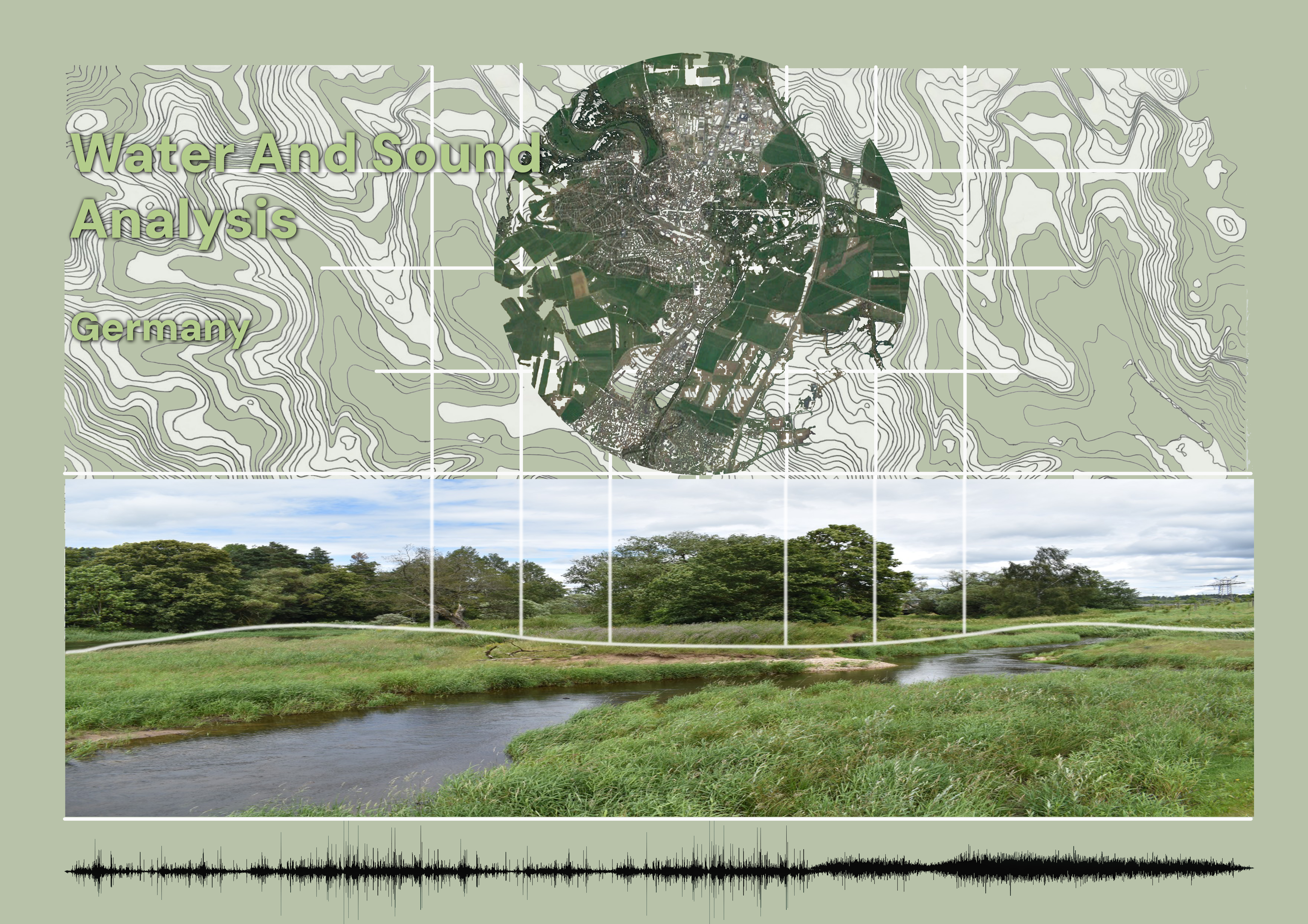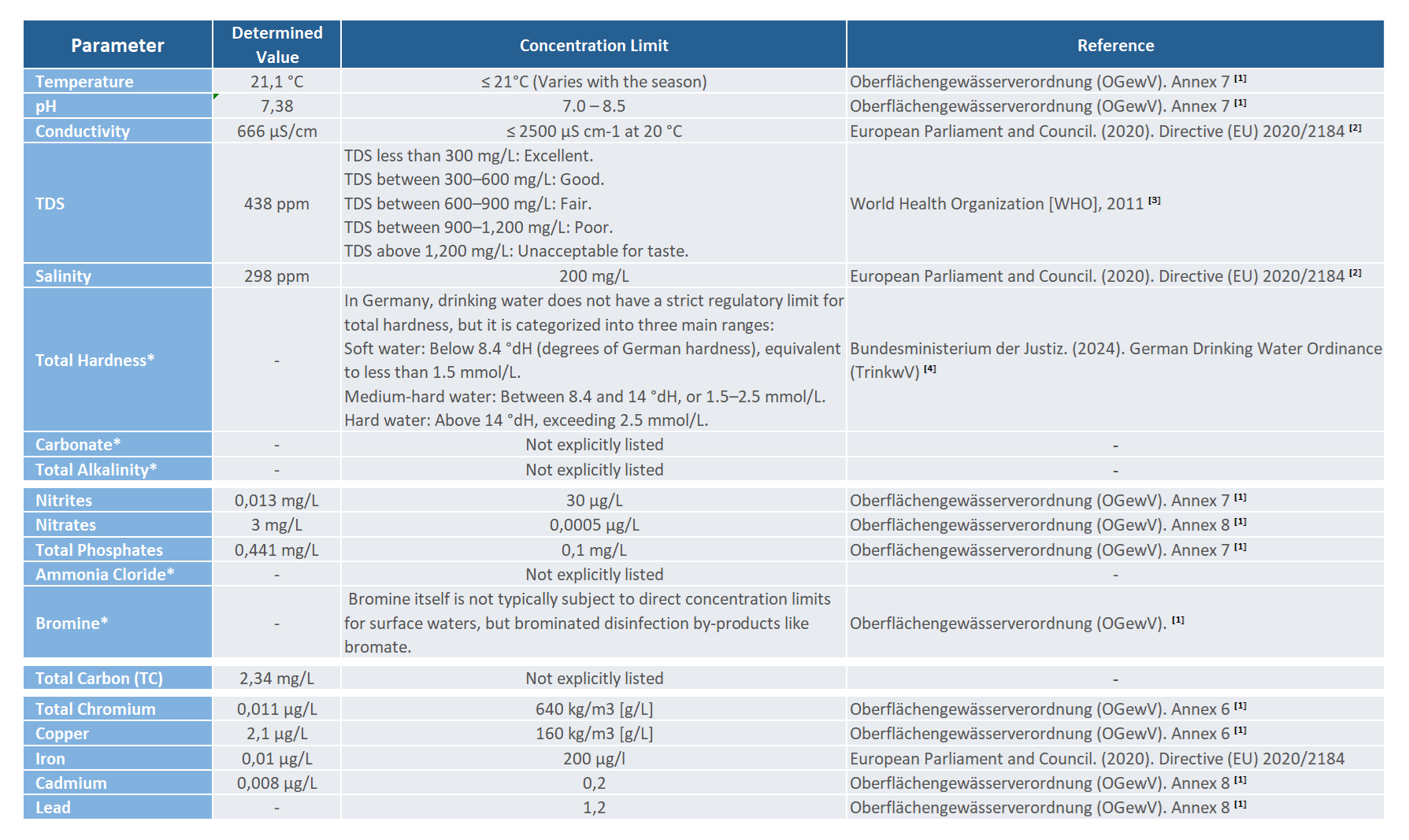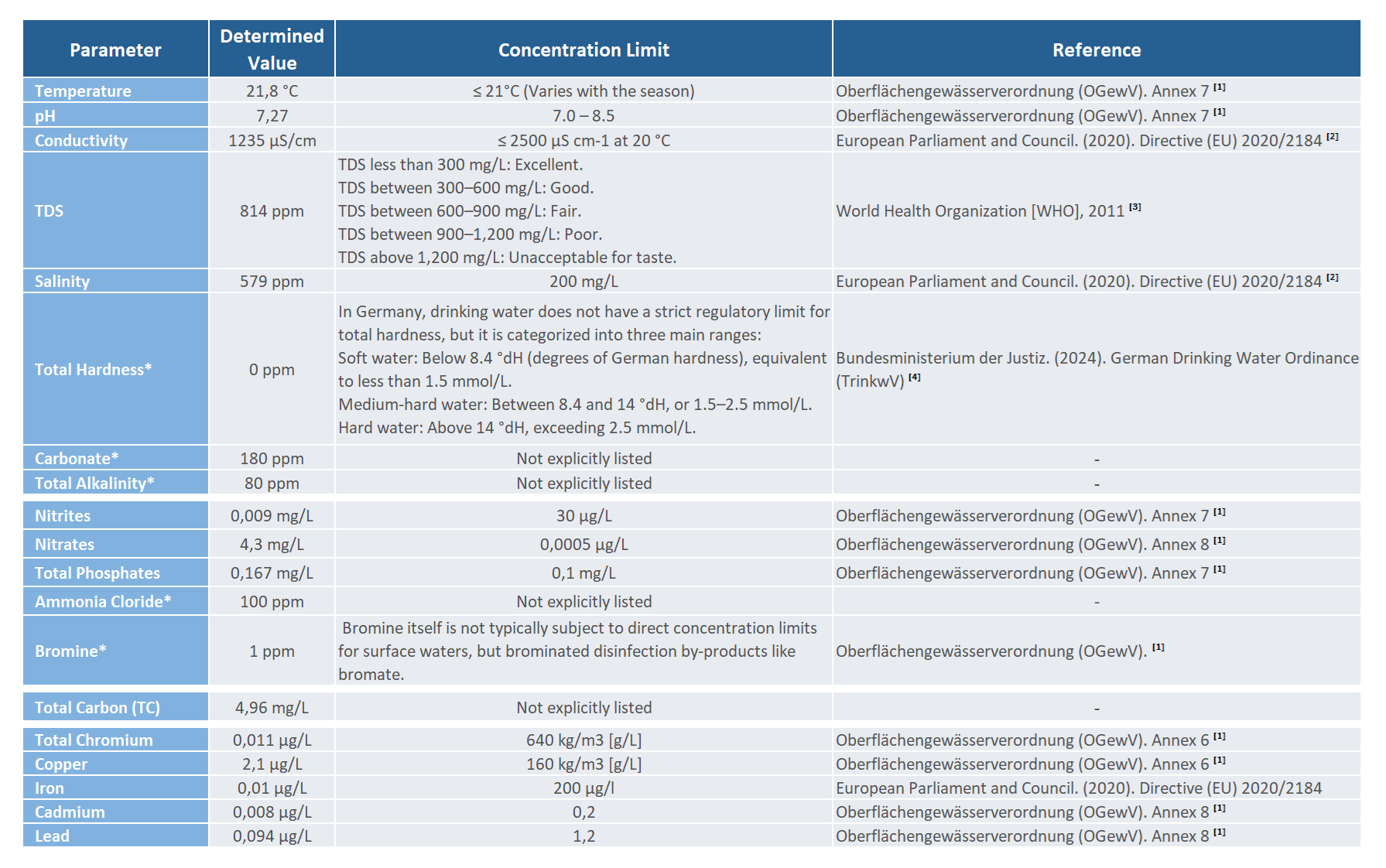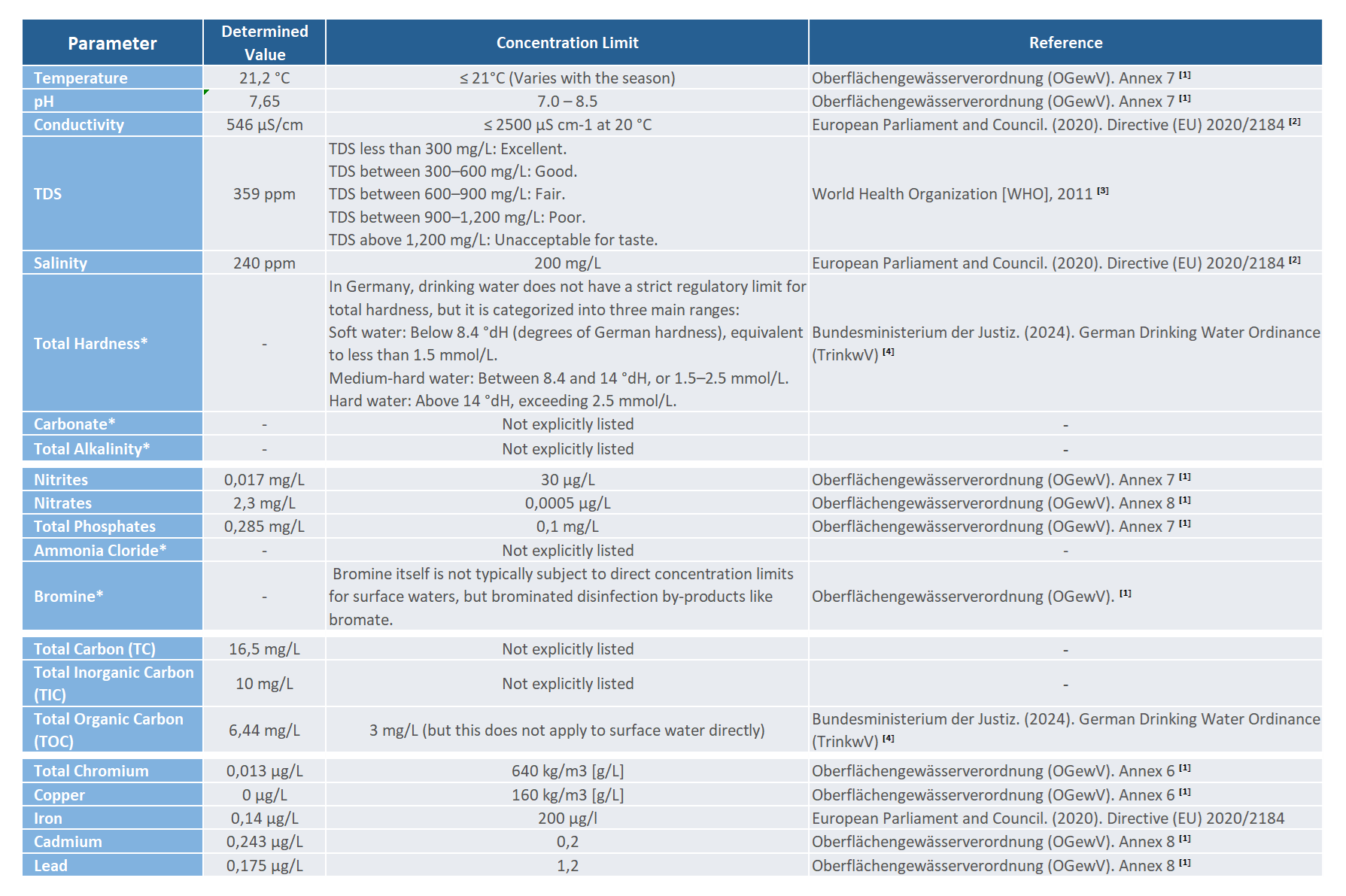Sound and Water Analysis
Donaueschingen, Germany

Sound Analysis
Date: 04.07.2024
Time: 14.40 hrs
Location: Donauursprung (Origen of the Danube – Auepark)
Atmospheric Situation:
Step into a tranquil setting where the sky is cloaked in soft clouds, creating a peaceful and introspective mood. The calm air and muted light make for a soothing environment:
-
- Gray-Hued Skies: The sky is fully overcast, with clouds stretching across the horizon in a gentle, uniform layer.
- Soft Lighting: The diffused light from the clouds bathes the scene in subtle, understated tones.
- Quiet Ambiance: The stillness of the cloudy atmosphere enhances the sense of calm and serenity.
Water Analysis
Donauursprung (Origin of Danube - Auepark)

Analysis
Surface water from the Donauursprung, a key location marking the origin of the Danube River in Germany, was analyzed to assess its quality. This evaluation integrated multiple regulatory frameworks, including the Oberflächengewässerverordnung (OGewV), the European Directive (EU) 2020/2184, World Health Organization guidelines (WHO, 2011), and the German Drinking Water Ordinance (TrinkwV, 2024). While the OGewV primarily governs surface water quality, it does not cover certain parameters analyzed, necessitating supplementary references from international and European standards. Employing this holistic approach ensures a more comprehensive understanding of the water quality at this sampling point, addressing both local ecological requirements and broader public health considerations.
Several parameters complied with the respective regulatory limits, reflecting the water’s suitability for various uses. The pH value of 7.38 falls well within the OGewV’s acceptable range of 7.0–8.5, maintaining favorable conditions for aquatic life. The conductivity of 666 µS/cm is significantly below the European Directive limit of 2500 µS/cm, indicating low levels of dissolved ionic substances. Similarly, the nitrite concentration of 0.013 mg/L meets the OGewV limit, ensuring minimal impact on aquatic ecosystems and human health. Heavy metals such as total chromium (0.011 µg/L), copper (2.1 µg/L), cadmium (0.008 µg/L), and iron (0.01 µg/L) were detected in concentrations far below their respective thresholds, showcasing minimal industrial or agricultural contamination. These results suggest that the water is chemically stable and supports both ecological balance and potential human use within regulatory guidelines.
However, certain parameters exceeded their recommended limits, raising potential concerns. The total dissolved solids (TDS) value of 438 ppm, categorized as “fair” under WHO guidelines, and a salinity of 298 ppm, exceeding the European Directive threshold of 200 mg/L, suggest the presence of significant dissolved substances that could affect water taste and ecological functions. Most notably, the total phosphate concentration of 0.441 mg/L exceeds the OGewV limit of 0.1 mg/L, raising concerns about eutrophication, which could lead to algal blooms and oxygen depletion in downstream ecosystems. These findings highlight areas requiring targeted interventions, such as reducing nutrient runoff, to mitigate the potential ecological and health impacts.
Donauquelle

Analysis
The surface water sample was collected from the Donauquelle, the origin of the Danube River in Germany. This analysis considered four key regulatory frameworks for assessing water quality: the Oberflächengewässerverordnung (OGewV), the European Directive (EU) 2020/2184, World Health Organization guidelines (WHO, 2011), and the German Drinking Water Ordinance (TrinkwV, 2024). These regulations offer comprehensive benchmarks for evaluating various water parameters. However, since the German law for surface water (OGewV) does not explicitly cover all the parameters analyzed in this study, alternative regulations, such as the European Directive and WHO guidelines, were referenced to provide a more complete overview. The inclusion of multiple regulatory frameworks ensures a robust assessment of the water quality at the sampling point, allowing for a thorough evaluation in light of both local and international standards.
Several analyzed parameters met the regulatory standards, reflecting the overall good quality of the surface water. For instance, the pH level (7.27) aligns with the recommended range of 7.0–8.5 outlined in OGewV Annex 7, ensuring that the water remains neither too acidic nor too basic for most aquatic organisms. Conductivity, measured at 1235 µS/cm, is well below the European Directive’s threshold of 2500 µS/cm, indicating the absence of excessive ionic substances that could disrupt ecological balance. Nitrites (0.009 mg/L) and nitrates (4.3 mg/L) were within their respective limits, supporting the safety of the water for human and environmental health. Heavy metals, including total chromium (0.011 µg/L), copper (2.1 µg/L), cadmium (0.008 µg/L), and lead (0.094 µg/L), also remained within permissible concentrations, suggesting minimal contamination from industrial or agricultural sources. These findings collectively suggest that the water quality meets critical chemical and physical benchmarks, which are crucial for maintaining both ecological integrity and usability for various purposes.
Conversely, some parameters exceeded their respective regulatory limits, posing potential risks to water quality and ecological health. The temperature of 21.8 °C slightly surpassed the OGewV seasonal maximum of 21 °C, which may impact aquatic ecosystems, especially sensitive species. The total dissolved solids (TDS) of 814 ppm and salinity of 579 ppm exceeded the thresholds for excellent or acceptable water quality under the WHO and European Directive standards, suggesting a diminished taste quality and potential long-term impacts on human and ecosystem health. Moreover, total phosphates (0.167 mg/L) exceeded the OGewV limit of 0.1 mg/L, potentially contributing to eutrophication, which can lead to algal blooms and oxygen depletion. These findings underscore the need for ongoing monitoring and management strategies to address these exceedances and mitigate their potential effects.
Schützenbrücke (Poststraße)

Analysis
The Brigach River, one of the headwaters of the Danube River, was analyzed to evaluate its surface water quality. The assessment adhered the Oberflächengewässerverordnung (OGewV), the European Directive (EU) 2020/2184, World Health Organization guidelines (WHO, 2011), and the German Drinking Water Ordinance (TrinkwV, 2024). These frameworks provide an integrated perspective on water quality, considering ecological integrity and public health.
Several parameters demonstrate compliance with regulatory standards, reflecting favorable water quality in several respects. The pH of 7.65 is within the OGewV guideline of 7.0–8.5, ensuring a neutral to slightly alkaline environment conducive to aquatic life. Conductivity at 546 µS/cm is well below the limit of 2500 µS/cm, indicating relatively low ionic content. Nitrite levels at 0.017 mg/L also comply with the OGewV limit, showcasing minimal pollution from organic nitrogen compounds. The absence of detectable copper and low iron levels (0.14 µg/L) further indicate limited metal contamination. These metrics collectively suggest that the Brigach River maintains essential chemical and biological balance, supporting its ecological function.
Nevertheless, several parameters exceed established limits, requiring attention. The temperature recorded at 21.2 °C slightly surpasses the seasonal OGewV threshold of 21 °C, which could stress thermally sensitive aquatic organisms. Salinity (240 ppm) exceeds the 200 mg/L European Directive limit, indicating a higher concentration of dissolved salts, which may impact water taste and aquatic life. The total dissolved solids (TDS) value of 359 ppm is categorized as „good“ by WHO standards, though it does not reflect optimal quality. Alarmingly, total phosphate levels reach 0.285 mg/L, far above the OGewV limit of 0.1 mg/L, raising concerns about nutrient loading and potential eutrophication. Cadmium concentration (0.243 µg/L) also exceeds the permissible limit of 0.2 µg/L, highlighting potential contamination from industrial or agricultural sources. Lastly, the total organic carbon (TOC) concentration of 6.44 mg/L, while not explicitly regulated for surface water, significantly exceeds the TrinkwV limit for drinking water, suggesting organic matter pollution.
These findings indicate that while the Brigach River generally meets basic ecological and public health standards, targeted interventions, such as reducing nutrient and heavy metal runoff, are necessary to mitigate the identified exceedances. This will help preserve its ecological value and improve its quality for downstream uses.
References:
[1] Federal Ministry of Justice and Consumer Protection. (2016). Oberflächengewässerverordnung (OGewV) [Surface water ordinance]. https://www.gesetze-im-internet.de/ogewv_2016/index.html#BJNR137310016BJNE002400000
[2] European Parliament and Council. (2020). Directive (EU) 2020/2184 of the European Parliament and of the Council of 16 December 2020 on the quality of water intended for human consumption. https://eur-lex.europa.eu/legal-content/EN/TXT/?uri=CELEX%3A32020L2184
[3] World Health Organization. (2011). Guidelines for drinking-water quality: Fourth edition, incorporating the first addendum. https://www.who.int/water_sanitation_health/publications/2011/dwq_guidelines/en/
[4] Bundesministerium der Justiz. (2024). Trinkwasserverordnung (TrinkwV) [Drinking water ordinance]. https://www.gesetze-im-internet.de/trinkwv_2001/
